#sarah ponsonby
Explore tagged Tumblr posts
Text
me and who
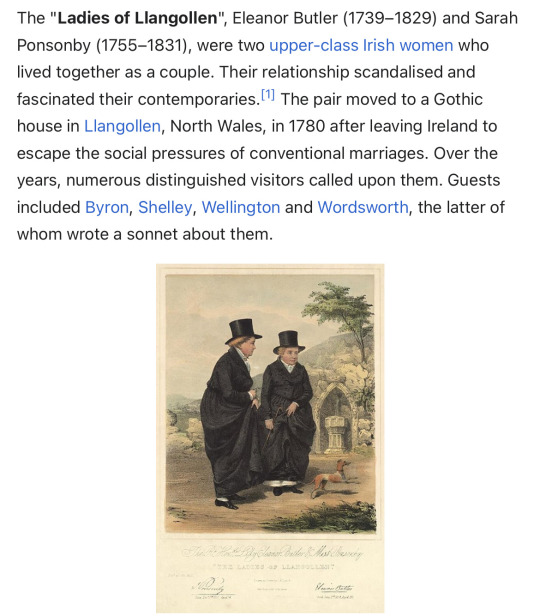
#ladies of llangollen#eleanor butler#sarah ponsonby#goth girls#irish history#lgbt#lgbtq#meme#gothic#sapphic#memes#history#percy shelley#lord byron#william wordsworth#duke of wellington#lesbian#lesbian history#wlw#goth lesbian#queer#goth#goths#goth girl#goth gays
357 notes
·
View notes
Text
Her attraction to heights accompanied her fear that she might be tempted to leap. Each time, she went grimly aloft to experience the possibility of a fall.
The Ladies, by Doris Grumbach
#page 100#the ladies#doris grumbach#the ladies of llangollen#lady eleanor charlotte butler#lady eleanor butler#eleanor butler#sarah ponsonby#Plas Newydd#queer lit#lgbtq+ lit#heights#call of the void#high place phenomenon#quote#quotes#literature#book#booklr#reading
3 notes
·
View notes
Text
Sarah Ponsonby's tombstone in Llangollen churchyard describes Lady Eleanor Butler as her 'beloved companion'.
"Normal Women: 900 Years of Making History" - Philippa Gregory
#book quote#normal women#philippa gregory#nonfiction#sarah ponsonby#llangollen#churchyard#eleanor butler#tombstone#beloved companion
0 notes
Text
This portrait of the Ladies of Llangollen goes some way to repeat the slander against them: that they were an 'odd' couple, dressed in masculine clothing and mimicked husband and wife. James Henry Lynch copied Margaret Parker's secret of drawing the faces of these inseparable friends, Eleanor Butler (c.1738-1829) and Sarah Ponsonby (c.1755-1831), without permission and added the manly jackets, men's top hats and their well-known garden scene, and mass-produced the image.
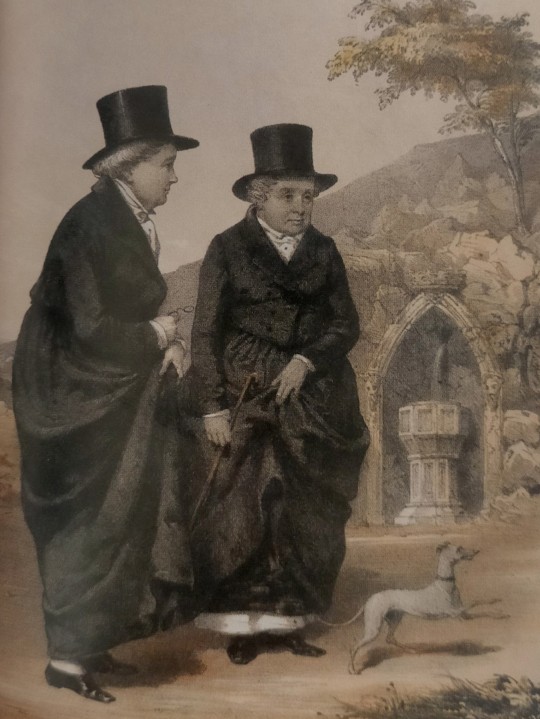
"Normal Women: 900 Years of Making History" - Philippa Gregory
#book quotes#normal women#philippa gregory#nonfiction#ladies of llangollen#slander#odd couple#menswear#fit check#james henry lynch#mary parker#secrets#inseparable friends#eleanor butler#sarah ponsonby#jacket#top hat#garden scene#mass production
1 note
·
View note
Text
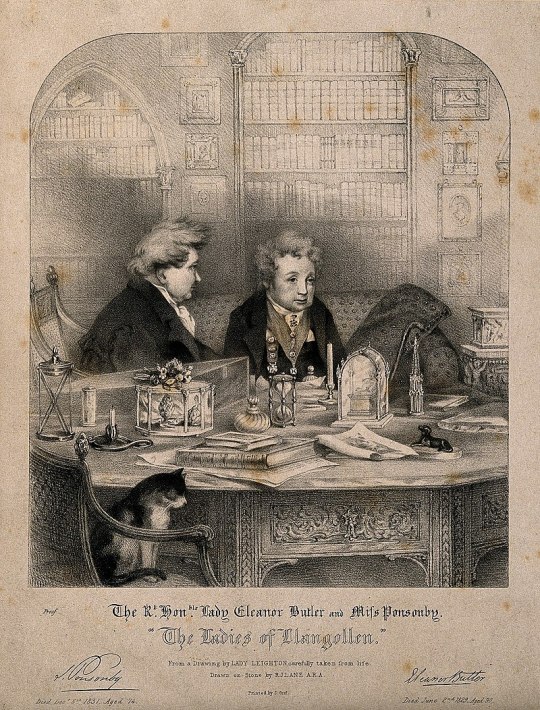
Sarah Ponsonby and Lady Eleanor Butler in their library (after 1831) by an unknown artist
7 notes
·
View notes
Text
Eleanor Butler and Sarah Ponsonby, the Ladies of Llangollen, were two Irish women who fell in love. Renowned international oddities, these women lived together and slept in the same bed. Together with their maid and their succession of dogs named Sappho, the two collected gothic art and lived happily ever after.
Support Making Queer History on Patreon
Send in a One-Time Donation
#ladies of llangollen#queer history#queer#lgbt#lgbt history#lesbian history#making queer history#irish history#ireland
320 notes
·
View notes
Text
I realized that the best example to make my point is the Ladies of Llangollen, Eleanor Butler and Sarah Ponsonby.
The Ladies were a pair of female friends who ran away together in 1778, dressed in men's clothes; they were caught and separated, but made another escape attempt that was more successful, and their families reluctantly allowed them to go their own way. Minor celebrities, their neighbors just knew them as a pair of eccentric ladies who kept house together while people in the know came from far away to visit them.
They habitually wore masculine-styled riding habits. They were buried in the same grave (along with the servant who helped them elope, Mary Caryll). Butler left a diary that said nothing about them having sex. Some in the period suggested they were lesbians and they reportedly were shocked. This was an era where men and women had same-sex "romantic friendships" that were more effusive than what we'd consider platonic today. Anne Lister, Definite Lesbian*, visited them.
All of these data points can be interpreted in two ways, one implying they're queer and one taking it for granted that they weren't.
Riding habits: They're the closest women could get to men's or gender-neutral clothing in the Georgian era / They're practical and hard-wearing
Same grave: They were in love and wanted to be buried like spouses / They were best friends and didn't want to be separated
Diary: Butler didn't want to provide proof of what would have been considered wrongdoing to anyone who found her notes / Butler just didn't have any romance or sex to record
Shocked: They worried about exposure and had to pretend to be horrified at the thought / They genuinely were not behaving as anything except platonic friends and were genuinely shocked
Effusive: Many romantic friendships were in fact what we'd call queer today, acceptable to the world as non-sexual homoromantic relationships / Romantic friendships were between straight friends, like it says on the tin
Anne Lister: Lister recognized a kinship with these women and wanted to be part of their network or validate her sexuality through their acceptance or something / Lister was imposing her own take on their relationship or just admired them as independent women
Neither option is more objectively true. The first interpretations are simply using a different lens than the second, one that presumes that the Ladies being queer is a possibility.
Our culture generally teaches us that straight is the default, that everyone is far and away more likely to be straight than anything else, so it's not only safe, but the most sensible thing to do to choose an interpretive lens that doesn't bother engaging with the possibility of queerness. With this assumption in place, any reading of historical evidence (visual or textual) that doesn't exhaust all possible straight readings before moving on to a queer one is suspect as not having scholarly rigor. (It's also, of course, seen as much worse to consider someone queer if they would call themselves straight than to do the reverse, in general.)
People on the street do this and historians who don't have any background with queer theory do it too. That doesn't make it the only correct way to talk about the potential queerness of historical figures, and in fact more historians are developing the ability to balance potential queer readings with others!
Complete rigidity about this these days is, in fact, generally a sign that someone has very little interaction with real, contemporary historical scholarship. The study of history is not an attempt to determine all the facts of the past, but an attempt to interpret them in many different ways in order to illuminate what might otherwise be ignored.
If you want to read more about the Ladies of Llangollen, how they've been perceived, and how good historians deal with the ambiguity of queer readings of history, I would recommend “Extraordinary Female Affection”: The Ladies of Llangollen and the Endurance of Queer Community by Fiona Brideoake, which appears to be open access.
*Anne Lister, I should mention, has only been considered a Definite Lesbian herself since the translation of the sexually explicit parts of her diaries from code, because We Must Always Presume Straightness even if a historical woman behaves highly unconventionally for a straight woman of her time. Actually, they were decoded in the early 20thc by a Lister descendant and literally hidden again because, if only 100% serious proof allows a queer interpretation of someone's actions, lacking that proof means that nobody will be able to seriously speculate without getting called a loser writing fanfiction.
#history#queerness#sure the r/sapphoandherfriend school of reading any possible queer reading as fact that's being repressed is bad#but it's also much smaller and much less influential than the mainstream heteronormative one so why waste time on it?#ladies of llangollen#anne lister
69 notes
·
View notes
Text
While reading a guide of Wales in anticipation of my next holiday, I discovered the beautiful story of Eleanor Butler and Sarah Ponsonby, known as the Ladies of Llangollen. These two Irish women loved each other and, in order to live their love in peace, at the end of the 1700s they ran away together and eventually stopped in Wales (precisely in Llangollen) where they went to live in a cottage and there they spent their whole lives together. I'm delving into their story, and not only because a forbidden love that finds refuge in a cottage for a peaceful life is something that reminds me too much of our beloved Aziraphale and Crowley, but also because these two women were truly courageous. I'm really happy to have met them.
William Wordswordth described their love with these words:
A love allowed to climb, even on this earth, above the reach of Time
#ladies of llangollen#wales#queer history#lgbtq+ rights#love is love#good omens#crowley#aziraphale#south downs cottage
31 notes
·
View notes
Text
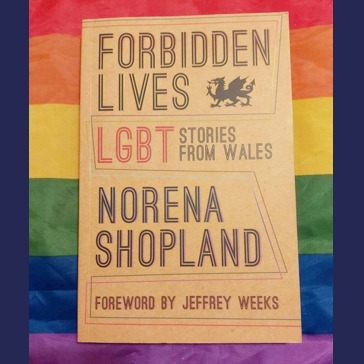
Y llyfr heddiw yw 'Forbidden Lives' gan Norena Shopland, a gyhoeddwyd yn 2017.
Mae'r llyfr hwn yn gasgliad o hanes LHDTC+ Cymru. Mae'n un o'r ychydig lyfrau ar y testun Cymru a pobl LHDTC+ (fel Llyfr y Dydd ddoe ac echdoe!). Mae'r ysgrifen Shopland yn goeth a manwl iawn. Mae hi'n defnyddio ei hymchwil yn y llyfr i ddangos hanes bobl LHDTC+ aneglur, fel Edith Gertude Phillips (g. 1886). Mae Shopland yn disgrifio hanes pobl LHDTC+ nodedig fel y Eleanor Butler a Sarah Ponsonby, hefyd.
Mae'r llyfr hwn yn un o fy hoff lyfrau!
Ydych chi wedi darllen y llyfr hwn?
/
Today's book is 'Forbidden Lives' by Norena Shopland, published in 2017.
This book is a compilation of Welsh LGBTQ+ history. It is one of the few books on the subject of Wales and LGBTQ+ people (like the Book of the Day yesterday and the day before yesterday!). Shopland's writing is exquisite and very detailed. She uses her research to show the history of less well-known LGBTQ+ people, such as Edith Gertude Phillips (b. 1886). Shopland describes the history of more well-known LGBTQ+ people also.
This book is one of my favourite books!
Have you read this book?
38 notes
·
View notes
Text
For Pride Month I would like to introduce you all to the Ladies of Llangollen, a lesbian power couple of the 18th century, Eleanor Butler (1739-1829) and Sarah Ponsonby (1755-1831). The two met in 1768, Ponsonby was a teenager and Butler was in her late twenties. They were from wealthy Irish families (aristocracy), but didn't want to be married off. Ten years after they met they ran away together with a dog. They dressed as men, but was found by their families because of their barking dog.


Their families wanted to send them to convents, but for whatever reason their families were convinced to let them go and be together as long as they left Ireland, I suppose to escape the shame they had casted upon their families for being very public lesbians. The two left Ireland for Wales, and travelled together before settling down in the town Llangollen in 1780 (Ponsonby was 25 and Butler was 41). They lived together as a couple for almost 50 years with Mary Carryl, their FEMALE servant, and a series of dogs named Sappho.
Being part of the aristocracy and very public about NOT marrying, being sisters in love as they say, the two were a bit of a curiosity amongst the rich & nobility. They were provided with a small stipend from intolerant families, donations from friends etc. They were so well known that they reached celebrity status! Papers wrote about them (they sued them!), art was made of them, and they had VERY RICH & VERY KNOWN guests.
Their guests included people such as William Wordsworth, Lord Byron, Charles Darwin, the Duke of Wellington and many more. King George III eventually provided the ladies with a royal pension based on the advice of Queen Charlotte... Bcos she wanted to visit their cottage.
ALSO, REMEMBER THEIR FEMALE SERVANT Mary Carryl (d. 1809)? Well, the woman was super loyal to them, and when she passed away she left the land she owned to Sarah! NOW, this could just be a deep friendship, bcos Sarah & Eleanor did save her from a shitty situation, BUT, our Ladies of Llangollen are buried together in the same plot with the same grave marker as MARY CARRYL. So, friendship or a nice lesbian polygamous RELATIONSHIP even in death?! I leave it to you to decide dear readers.
11 notes
·
View notes
Text
Her ears closed upon the sound of Eleanor's voice assuring her that once again they would manage their escape together, somehow: nothing, no one, would prevent them.
The Ladies, by Doris Grumbach
#page 202#the ladies#doris grumbach#the ladies of llangollen#lady eleanor charlotte butler#lady eleanor butler#eleanor butler#sarah ponsonby#Plas Newydd#queer lit#lgbtq+ lit#death#dying#love#quote#quotes#literature#book#booklr#reading
0 notes
Text

This charming book has a small chapter on same-sex relationships and tells of Georgian-period terminology (mostly regarding gay men and women, in that order!) and people of note. What the Georgians got up to is of interest to us here, as Dublin was a Georgian city and of course, the laws made in London during the Georgian period affected Ireland. Therefore, if you could be hanged for "sodomy" in England, you could be strung up in Ireland too.
But the book goes into the nuance of everyday life in the period versus what may be written in the law books. For example, in 1822, the Anglican Bishop of Clogher in Northern Ireland had been caught in the act with a guardsman - the Bishop was dismissed from his position, but from the public's point of view, he became a figure of fun and jokes. And so same-sex activity was "semi-known and semi-secret"; very serious and dangerous on one hand and part of the furniture and a source of amusement on the other.
Another hint at the Georgian's attitude toward queerness is the sheer number of terms used to refer to it! For the gay men we had "mollies", "back-gammon players" and "catamites" (a Classical reference to the mythologically handsome adolescent boy, whose beauty caused Zeus to steal him away to Olympus to serve him). For the lesbians we had "flats", "tommies" and "rubsters". In fact, it is semi-jokingly stated that lesbians did not exist before 1870, because the more euphemistic terms were in use instead!
These terms for same-sex love and identity shows an emergent social awareness for the LGBTQ community in the Georgian era. Albeit mostly for the L and the G!
And of course we know that lesbians existed in Ireland before 1870, just one example being "The Ladies of Llangollen", two upper-class ladies who lived together (with only one bed in the house!) for 50 years. While numerous Georgian ladies lived together as companions, Eleanor Butler and Sarah Ponsonby declared their loving relationship openly in upper-class society.
It seems that historical relevance and the holding of a powerful position in society both protected queer Georgians/Anglo-Irish aristocrats from punishment and encouraged historians to record their lives for our historical interests today. Therefore, there are no mention of everyday, "lower-class" Irish queers in this chapter of The Georgians. This is certainly a sad oversight in our LGBTQ+ history. But it's fun to read about 18th and 19th century queer people of note, especially the tommies and "female husbands" who I always picture dressed up like Gentleman Jack!
6 notes
·
View notes
Text
ELEANOR BUTLER & SARAH PONSONBY // NOBLEWOMAN
“They were known as the Ladies of Llangollen, who were two upper-class Irish women who lived together as a couple. Their relationship scandalised and fascinated their contemporaries. The pair moved to a Gothic house in Llangollen, North Wales, in 1780 after leaving Ireland to escape the social pressures of conventional marriages. Over the years, numerous distinguished visitors called upon them. Guests included Byron, Shelley, Wellington and Wordsworth, the latter of whom wrote a sonnet about them.”

4 notes
·
View notes
Note
👤⏰ and 👔 for the GTA 5 ask game?
👤20. If you have a GTAV OC, tell me about them!
Why did I JUST realize @spookydiner literally already asked me about husbandkiller? Sorry bout that. I guess she hasn’t gone anywhere.
She was born on April 28th, 1972 in Barbados and baptized as Lourdes Vil, though by the time she was ten years old she had been given the rather rude nickname “Dog Tooth” on account of the gaps in her teeth. When she was sixteen, she immigrated to Carcer City to live with a family friend, Xaviera, and spent five years working at a nursing home.
In the winter of 1992, Lourdes met and began to sleep with a man named Armand, the son of a resident at the home. With his help, she and Xaviera began counterfeiting US currency and traveling cross-country to spend their ill-gotten gains on untraceable material assets. Lourdes developed a taste for the finer things during this time, and she enjoyed the freedom, spontaneity and ever-changing scenery.
Unfortunately, a few years into this lifestyle, the site which the duo had previously used to make their bills was discovered and their assets stashed back in Carcer City seized. Shortly thereafter, she and Xaviera had a nasty falling out. Lourdes took her share of their remaining money and drifted to San Andreas, changing her name to “Mable” to be less identifiable. In 2003, she got married to Butch Stewart, the owner of the Alamo Auto Salvage. Butch was a neglectful and stingy husband, due in part to his distraction with Sarah Vincent, a member of the Lost MC.
Butch eventually got Sarah pregnant, and she gave birth to a son named Carl. When Mable found out, she shot Butch in his sleep, burning his corpse in the scrap yard’s incinerator. As inheritor of the estate, she continued to work with both the Lost and other local gangs, disposing of evidence and bodies alike. She keeps tabs on the Lost in case someone in their corner gets pissy about Butch’s death.
Mable has a brand of a heart with an arrow through it on her upper back, and she gets fatter as she ages. When Tonya eventually wanders to Sandy Shores in withdrawal, Mable gives her a place to recover.
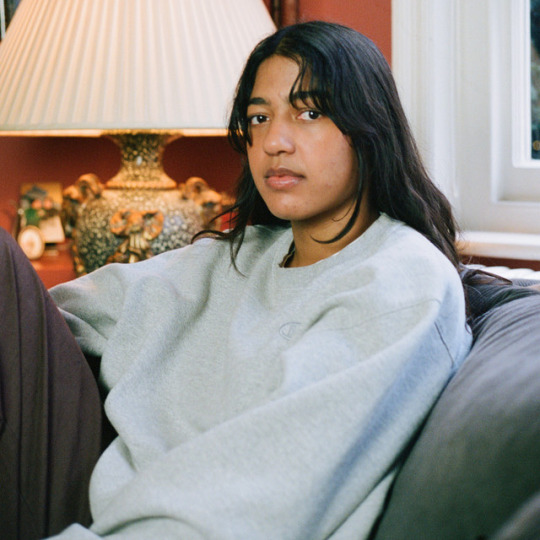
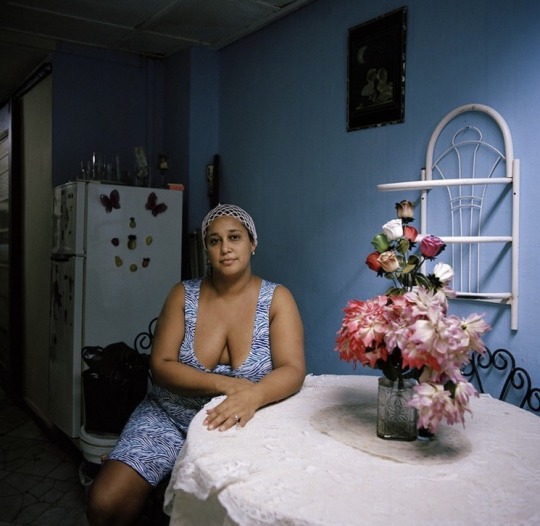
⏰ 3. How long have you been into GTA V (or the GTA series in general?)
Since late 2020. I started school in the dead of winter, in the middle of full-swing Covid restrictions, coming out of one of the worst periods of my life. I played on a projector in my dorm room. Loved it. The sunny, lighthearted atmosphere really kept me sane.
👔 13. What is your favourite clothing store in-game?(Ponsonbys, Binco, Suburban, discount stores)
Suburban. They’ve got the best options for all three characters; the discount store is kinda Trevor’s place, Ponsonbys’ is for Michael (and Frank’s earrings,) etc. I really wish we had more jewelry options for all three of the mains. I LOVE those little studs Franklin can wear, and I really think Michael would look good in a watch. And we can put Trevor in nipple rings.
#serenityby#asks#gta v#gta 5#Mable Stewart#Tonya Wiggins#trevor philips#⬅️because I originally made Mable to plow Trevor lol#I’ve since had her evolve. she gets railed by lots of people now.#(significantly less smelly ones!)
3 notes
·
View notes
Text
The irresistible tale of their passionate, 50-year “romantic friendship” and the elaborate, beautiful home and garden they constructed made them famous in their own lifetimes, and they have remained a symbol of enduring same-sex happiness ever since. They are “queer foremothers”, as a newly rereleased book about the Ladies, Chase of the Wild Goose, puts it.
#the ladies of llangollen#i’ve been there many years ago and yes you do feel them#they made it such a lovely and peaceful place bless them
13 notes
·
View notes
Note
https://www.theguardian.com/world/2023/jan/31/sarah-ponsonby-eleanor-butler-love-story-ladies-of-llangollen-wales Well, hadn't heard about their story before! Of course, someone has to say "I’d much rather think they had a happy and fulfilled sexual life than that they just sat and held hands" because there can be no happiness and fulfillment without boning (though no ace will be surprised to see this take...), and yes their status allowed them more freedoms, but anyway, here's some queer history.
--
10 notes
·
View notes